The Chrysemys scripta elegans species, more commonly referred to as a red-eared slider turtle, are found in wet and warm conditions between central and southern regions of the United States. Hence, red-eared sliders enjoy spending their time either foraging or bathing in a marsh, pond, or slow-moving water areas. Less often, these sliders can also be spotted in lakes and rivers.
When housing captive red-eared sliders, you will want to provide a similar setting to the wild environment they are native to, ensuring your animals thrive. Essential considerations to create a “wild-setting” for red-eared sliders entail the correct water conditions, which include the optimal water depth, temperature, and quality.
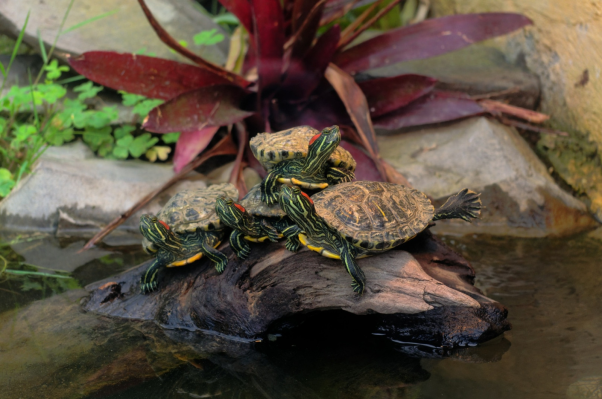 Credit: wallhere.com
Credit: wallhere.com
Life stages and water conditions
As hatchling and juvenile red-eared sliders are still developing their organs to establish a healthy metabolism and growth process, your younger sliders will require much warmer and cleaner water conditions than your adult sliders.
Optimal water conditions for younger (more hatchling) sliders include the following:
- Extreme clean, filtered water with at least three water changes per week.
- Water temperatures being between 78 and 84°F.
- Sufficient depth and quantity of water (10 gallons for every inch of shell length) for swimming and foraging, including enough basking area and irregular sand patches.
On the other hand, subadult and adult red-eared sliders are comfortable with average water temperatures of 68 to 82°F, warm basking areas of at least 85°F or preferably, 104°F, and at least 50 gallons of water for optimal swimming and foraging.
Generally, the water temperature should be between 75 and 85°F. In contrast, the basking area should provide a warmer temperature than the water at 85 to 95°F, and the nighttime water conditions can be anything between 65 and 70°F.
Quantity versus Quality of your water source
Water Quantity:
Red-eared sliders have virtually unlimited space in the wild to move around and get sufficient exercise or energy output for the food they eat. They do not have this luxury in captivity. That said, they are pretty happy in confined spaces, provided the water quantity does not exceed the walking and basking spaces.
So how much is too much water? It depends on the size of your tank enclosure or pond at the end of the day. Ideally, you want the water to be at a depth double the length of the average-size slider’s shell length.
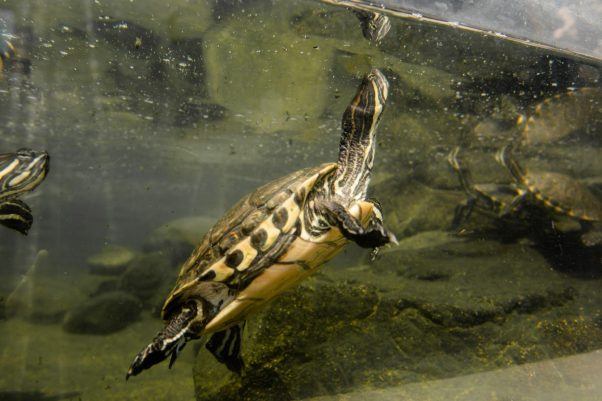
As you hopefully did all your research before investing in a red-eared slider as a pet, you will know that the species can grow relatively big and require more space for each inch they grow. Accordingly, rather opt for a larger tank capacity from the start to save money, which will also reduce the amount of effort it will take to set up your tank again.
What size tank or pond are you looking at, then? The smallest enclosure you can choose for juvenile to adult red-eared sliders is a 50- to 75-gallon tank or pond for six to 10 individuals. However, if you can go for a 90-gallon enclosure, you will hit the sweet spot. The bigger the tank, the better for your red-eared sliders. Yes, it will require more water and extended maintenance, but it will save you a lot of unnecessary veterinary visits and bills in the future.
Remember the rule of thumb: For every inch of shell growth, you should be able to add 10 gallons of water.
Water Quality:
Water conditions of the highest quality are critical for red-eared sliders’ health. As your animals will be spending the majority of their time in the water, the space will get dirtied with uneaten food, fecal matter, and urine relatively fast.
For outdoor ponds, you can expect faster water contamination because of more natural interactions such as sunlight causing photosynthesis and bacterial growth, turning the water green quicker, or heavy winds causing sediment residue to build up faster on the bottom of the pond.
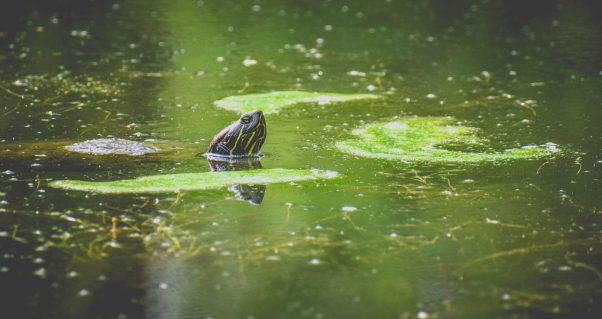
The less aesthetic-looking water and funny smells should be the least of your concern. The contaminated water is more troublesome to your red-eared sliders’ health. Sliders tend to take in or drink quite a bit of the water while swimming. Thus, if regular water changes and maintenance are not kept up, your red-eared slider(s) can become susceptible to diseases, gastrointestinal woes, skin and shell rot, and other lethal parasitic infestations.
At least once a week, water changes and regular cleaning should be done at a minimum. However, it is recommended that water changes and/or cleaning be completed on the same day that you do feeding. If you feed the red-eared slider(s) in a separate tank to that of the holding tank or pond, less frequent water changes will be required.
It is essential to use a dechlorinating agent to treat the tap water prior to filling up your tank or pond. If you are using rainwater, add some activated charcoal to kill any photosynthetic bacteria before putting your red-eared sliders back. By treating your water source appropriately, unnecessary health issues in your sliders can be avoided.
IMPORTANT NOTE: Do not forget to take the temperature reading of the water with a reliable thermometer, making sure it is at the correct temperature before putting your red-eared slider pet(s) back into their enclosure.
The importance of keeping the correct water temperatures
It is essential to know that red-eared sliders cannot thermoregulate internally because they are ectotherms or cold-blooded reptiles. This means that red-eared sliders depend on external sources to regulate their body temperature. Now you properly had the “AH-HA!” moment, realizing why they need and love basking areas so much.
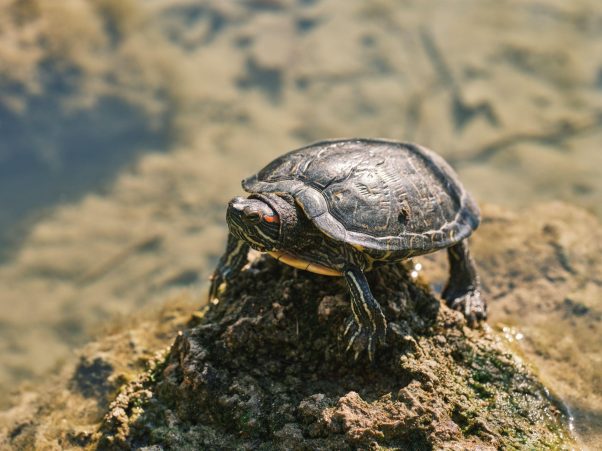
As you know, with outdoor ponds, you will most likely receive natural sunlight as a heat source. However, seasonality and the time of day should be kept in mind when considering an outdoor setup for which you might need to install a heater during those colder times.
On the other hand, you can use indoor tanks, but you will have to install a UV light and/or a heater to provide that additional heat they require to stay healthy. Let us go into more detail about what is necessary to regulate your water temperature for both setups individually.
Indoor tank water conditions:
- Water temperature:
Tank enclosures situated indoors are easier to manipulate regardless of seasonal changes. Therefore, you will most properly install a submersible heater with a thermostat in your indoor tank enclosure from the first day of setup.
Temperatures can be kept at 75 to 85°F in your tank, ensuring optimal conditions for healthy metabolisms and growth.
- Water depth:
Indoor enclosures tend to be smaller than their outdoor counterparts. However, red-eared sliders still require enough water depth to swim, forage, be active and still be able to bask and borrow in the sand when necessary. Using different elevation methods will help overcome some of these water challenges.
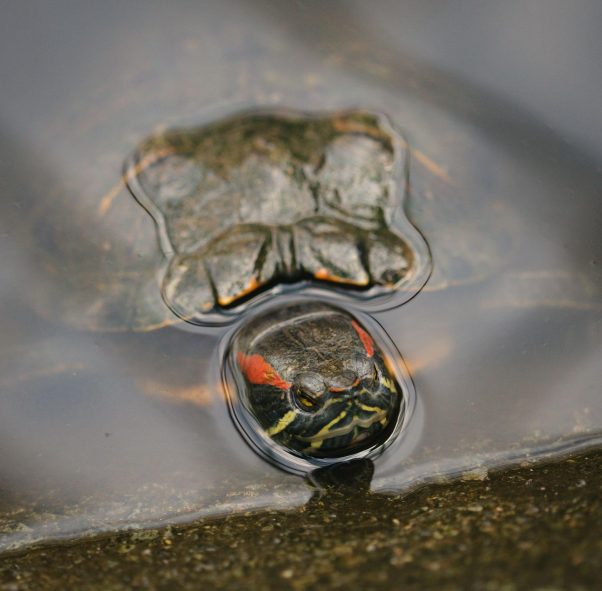
Thus, the water depth cannot be less than one foot deep but should preferably be more than that. The water depth should not surpass a depth equal to more than double the shell length of your average-size red-eared slider.
- Water filtration:
A proper filtration for your indoor tank is definite. Good quality water is of critical importance to your red-eared slider’s health.
Depending on your indoor tank’s design, it will look dirtier quicker than outdoor ponds and disturb you more than anything else because it is most properly in your living space.
As with a submersible heater, do yourself a favor and install a tank filter on the first day’s setup. While you are at it, you can install an air stone as well to assist with less frequent fouling and keep the water oxygenated.
Outdoor pond water conditions:
- Water temperature:
Depending on where you are situated in the United States, the summer and spring months can reach average temperatures of 72 to 90°F and 52 to 70°F, respectively. Therefore, outdoor ponds will do away with heating systems in the summer, where the water will be heated sufficiently through sun exposure.
As the seasons change and become colder, a submersible heater with a reliable thermometer can be used to keep the water temperature at optimal conditions.
- Water depth:
Red-eared sliders require at least a water depth of three feet for optimal swimming and foraging activities. However, if it is possible to create variable depths in the pond with pond inserts, sandbanks, or levelers, installing one or some of these is highly recommended. This way, your red-eared slider can rest when it needs to but also get exposed to sufficient air to avoid skin and shell rot.
- Water filtration:
Because an outdoor pond simulates a more natural environment than indoor tanks, you most properly do not need a filtration system.
However, if you do not want to do water changes as often and guarantee the best quality water for your red-eared slider(s), a filtration system is advisable. Otherwise, you can also install an air stone, continuously purifying and oxidizing the water. Have a look at the filter and other products TurtleHolic recommends.
When in doubt…
Always opt for a bigger enclosure size than what you think you need. Please ensure that wherever the enclosure goes, the area can take the weight of the tank or pond, including the gallons of water and “heavy” animals you will be adding to it.
If you are finding it hard to judge the quality of your water specifically, you can always get a water testing kit to assist in measuring the nutrient levels in the water. Accordingly, you will ensure healthy water conditions for your red-eared slider friends.
When you have doubts about your enclosure’s setup, do not hesitate to consult with more experienced aquatic turtle hobbyists, local pet shops, and animal centres, or even contact a herpetologist.

 Credit: wallhere.com
Credit: wallhere.com


